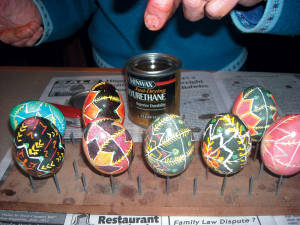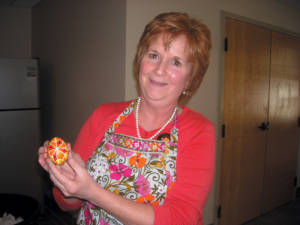Dipping into Ukrainian art of egg decorating
By Dawn De Busk
Staff Writer

Varnish is applied to the finished eggs during a Ukrainian egg-decorating workshop. Instructor Jodi Smith said, “I predict every egg in the class will be unique, even though we all started with the same pattern.â€
LOVELL – Chickens kept entering the conversation.
And, which came first – the chicken that laid the egg? Or, was the topic initially hatched when the eggs were held in the hands of a dozen women attending an egg-decorating workshop?
Actually, hens do lay eggs that are better at absorbing the vivid hues of dye, and some that are less prone to taking on the tones of the colors in which they are dipped.
“That depends on the chicken that laid the egg. Some eggs slurp the color right up, and others don’t as much,†said Jodi Smith, who teaches the traditional art of Ukrainian egg-decorating.
Smith taught the Thursday afternoon class at the Charlotte Hobbs Memorial Library in Lovell. The craft was not originally associated with Easter – since it predates Christianity in the Ukraine by about 700 years, she said.
“With children’s Easter eggs, the dyes have to be safe and non-toxic because those eggs will be eaten. People are not going to eat these eggs, so we can use the stronger dyes,†she explained as people took turns gently dropping an egg into the first jar of dye.
Participants followed a star pattern, with each step illustrated on a piece of paper. The eggs were dyed in this order: yellow, green (applied by cotton swab), orange, red and black. In between each layer, the artist used wax to preserve a design of the color that just been used. When the product was complete, it was heated in a toaster oven to soften and remove the wax.
The dying-and-waxing process took more than two hours to finish. So, there was ample time to talk.
Consequently, chickens wondered into the discussion.

Sharon Kelly, of Lovell, shows off her finished project at the end of a workshop on Ukrainian egg decorating. (De Busk Photo.)
The conversation arrived at Sue Mezzanotte’s tale of finally catching the fox that had been getting its nightly snack from her chicken coop, and how she had yelled ‘Drop it†to a wild animal that didn’t understand or heed commands in English. Laughter erupted, and talk turned to other dangers to the chicken pen: fisher cats and domestic dogs running unrestrained.
Then, the room was quiet, as they focused on the fine-motor-skill task of using a kistka. The tool measures half the size of an unused pencil. A tiny metal wire helps heat the black wax, which when melted travels to the application end. Essentially, the wax is the medium used to draw the designs on the egg.
“The trick is getting the wax hot enough so it is liquid, but not so hot that it blobs out,†Smith instructed.
As far as giving out tips on using the kistka effectively, Smith responded, “That is the part about practice. It takes a steady hand.â€
One participant said, “I wish there was a vice you could put the egg in.â€
Whether the women were intently and silently focused on the craft at hand or sharing observations, the dozen plus community members could not stop expressing how much fun they had at the workshop.
For Mezzanotte, the egg-art has intrigued her for decades.
“I’ve always loved these. Ever since I was a little girl, I’ve looked at them and wondered how they were made,†the resident of Stow said.
She summarized her experience in one word: Fun. In fact, doing the craft was so enjoyable for Mezzanotte that she planned to order on-line the necessary supplies and take another whirl at Ukrainian egg-decorating.
Sharon Kelly, of Lovell, said she signed up the workshop “because the library was nice enough to offer it.â€
“It was a lot of fun. It was so fun. I would love to do this again,†Kelly said, adding that some of the women at the table planned to share the cost of materials and do the project as a group.
“I knit and spin. So, adding another craft, well, there’s not enough hours in the day,†Kelly said.
Another Lovell resident, Carol Legault, became interested in the Ukrainian egg-decorating when Smith showed some of her finished eggs to a local knitting group.
“I don’t think I could do it on my own. It was quite a process,†Legault said after she finished wiping away the wax from her egg, and was smoothing the first layer of varnish over the shell.
“This workshop was wonderful,†she said. “The eggs came out beautiful – everyone’s design was different.â€

